[English] 日本語
 Yorodumi
Yorodumi- PDB-3htm: Structures of SPOP-Substrate Complexes: Insights into Molecular A... -
+ Open data
Open data
- Basic information
Basic information
| Entry | Database: PDB / ID: 3htm | ||||||
|---|---|---|---|---|---|---|---|
| Title | Structures of SPOP-Substrate Complexes: Insights into Molecular Architectures of BTB-Cul3 Ubiquitin Ligases: SPOPBTB/3-box | ||||||
 Components Components | Speckle-type POZ protein | ||||||
 Keywords Keywords |  PROTEIN BINDING / PROTEIN BINDING /  ligase / BTB / ligase / BTB /  SPOP / SPOP /  ubiquitin / ubiquitin /  Nucleus / Ubl conjugation pathway Nucleus / Ubl conjugation pathway | ||||||
| Function / homology |  Function and homology information Function and homology information regulation of proteolysis / Cul3-RING ubiquitin ligase complex / molecular function inhibitor activity / localization / Hedgehog 'on' state / protein polyubiquitination / proteasome-mediated ubiquitin-dependent protein catabolic process / nuclear speck / regulation of proteolysis / Cul3-RING ubiquitin ligase complex / molecular function inhibitor activity / localization / Hedgehog 'on' state / protein polyubiquitination / proteasome-mediated ubiquitin-dependent protein catabolic process / nuclear speck /  ubiquitin protein ligase binding / ubiquitin protein ligase binding /  nucleoplasm ... nucleoplasm ... regulation of proteolysis / Cul3-RING ubiquitin ligase complex / molecular function inhibitor activity / localization / Hedgehog 'on' state / protein polyubiquitination / proteasome-mediated ubiquitin-dependent protein catabolic process / nuclear speck / regulation of proteolysis / Cul3-RING ubiquitin ligase complex / molecular function inhibitor activity / localization / Hedgehog 'on' state / protein polyubiquitination / proteasome-mediated ubiquitin-dependent protein catabolic process / nuclear speck /  ubiquitin protein ligase binding / ubiquitin protein ligase binding /  nucleoplasm / nucleoplasm /  nucleus / nucleus /  cytoplasm cytoplasmSimilarity search - Function | ||||||
| Biological species |   Homo sapiens (human) Homo sapiens (human) | ||||||
| Method |  X-RAY DIFFRACTION / X-RAY DIFFRACTION /  SYNCHROTRON / SYNCHROTRON /  SAD / Resolution: 2.5 Å SAD / Resolution: 2.5 Å | ||||||
 Authors Authors | Zhuang, M. / Walden, H. / Schulman, B.A. | ||||||
 Citation Citation |  Journal: Mol.Cell / Year: 2009 Journal: Mol.Cell / Year: 2009Title: Structures of SPOP-substrate complexes: insights into molecular architectures of BTB-Cul3 ubiquitin ligases. Authors: Zhuang, M. / Calabrese, M.F. / Liu, J. / Waddell, M.B. / Nourse, A. / Hammel, M. / Miller, D.J. / Walden, H. / Duda, D.M. / Seyedin, S.N. / Hoggard, T. / Harper, J.W. / White, K.P. / Schulman, B.A. | ||||||
| History |
|
- Structure visualization
Structure visualization
| Structure viewer | Molecule:  Molmil Molmil Jmol/JSmol Jmol/JSmol |
|---|
- Downloads & links
Downloads & links
- Download
Download
| PDBx/mmCIF format |  3htm.cif.gz 3htm.cif.gz | 131.3 KB | Display |  PDBx/mmCIF format PDBx/mmCIF format |
|---|---|---|---|---|
| PDB format |  pdb3htm.ent.gz pdb3htm.ent.gz | 109.8 KB | Display |  PDB format PDB format |
| PDBx/mmJSON format |  3htm.json.gz 3htm.json.gz | Tree view |  PDBx/mmJSON format PDBx/mmJSON format | |
| Others |  Other downloads Other downloads |
-Validation report
| Arichive directory |  https://data.pdbj.org/pub/pdb/validation_reports/ht/3htm https://data.pdbj.org/pub/pdb/validation_reports/ht/3htm ftp://data.pdbj.org/pub/pdb/validation_reports/ht/3htm ftp://data.pdbj.org/pub/pdb/validation_reports/ht/3htm | HTTPS FTP |
|---|
-Related structure data
| Related structure data | 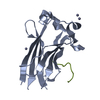 3hqhC 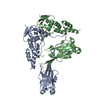 3hqiC 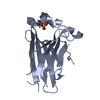 3hqlC  3hqmC  3hsvC  3hu6C 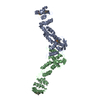 3hveC  3ivqC  3ivvC C: citing same article ( |
|---|---|
| Similar structure data |
- Links
Links
- Assembly
Assembly
| Deposited unit | 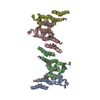
| ||||||||
|---|---|---|---|---|---|---|---|---|---|
| 1 | 
| ||||||||
| 2 | 
| ||||||||
| Unit cell |
|
- Components
Components
| #1: Protein | Mass: 19295.625 Da / Num. of mol.: 4 / Fragment: UNP residues 172-329 Source method: isolated from a genetically manipulated source Source: (gene. exp.)   Homo sapiens (human) / Gene: SPOP / Production host: Homo sapiens (human) / Gene: SPOP / Production host:   Escherichia coli (E. coli) / References: UniProt: O43791 Escherichia coli (E. coli) / References: UniProt: O43791#2: Water | ChemComp-HOH / |  Water Water |
|---|
-Experimental details
-Experiment
| Experiment | Method:  X-RAY DIFFRACTION / Number of used crystals: 1 X-RAY DIFFRACTION / Number of used crystals: 1 |
|---|
- Sample preparation
Sample preparation
| Crystal | Density Matthews: 3.78 Å3/Da / Density % sol: 67.47 % |
|---|---|
Crystal grow | Method: vapor diffusion, hanging drop / Details: VAPOR DIFFUSION, HANGING DROP |
-Data collection
| Diffraction source | Source:  SYNCHROTRON / Site: SYNCHROTRON / Site:  NSLS NSLS  / Beamline: X25 / Beamline: X25 |
|---|---|
| Detector | Date: Apr 20, 2005 |
| Radiation | Protocol: SAD / Monochromatic (M) / Laue (L): M / Scattering type: x-ray |
| Radiation wavelength | Relative weight: 1 |
| Reflection | Resolution: 2.42→50 Å / Num. obs: 37547 / Observed criterion σ(F): 0 / Redundancy: 1.9 % / Rsym value: 0.065 / Net I/σ(I): 25.5 |
| Reflection shell | Resolution: 2.42→2.51 Å / Redundancy: 1.7 % / Mean I/σ(I) obs: 4.9 / Rsym value: 0.335 |
- Processing
Processing
| Software |
| ||||||||||||||||||||
|---|---|---|---|---|---|---|---|---|---|---|---|---|---|---|---|---|---|---|---|---|---|
| Refinement | Method to determine structure : :  SAD / Resolution: 2.5→44.34 Å / σ(F): 0 SAD / Resolution: 2.5→44.34 Å / σ(F): 0
| ||||||||||||||||||||
| Refinement step | Cycle: LAST / Resolution: 2.5→44.34 Å
|
 Movie
Movie Controller
Controller





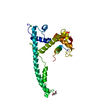


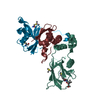

 PDBj
PDBj




